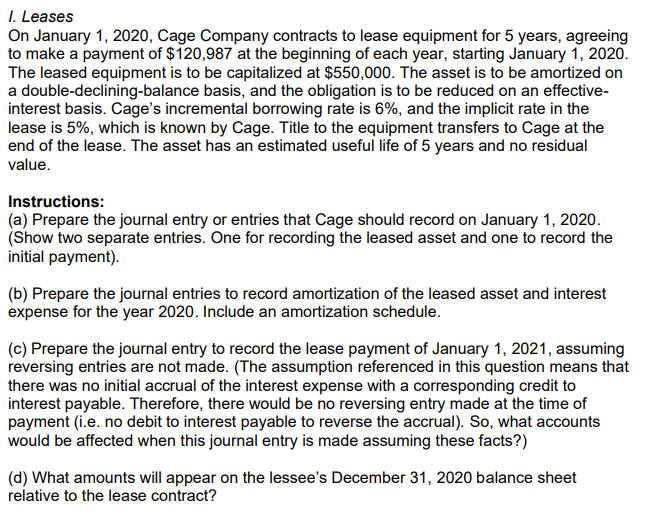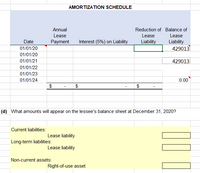1. Leases On January 1, 2020, Cage Company contracts to lease equipment for 5 years, agreeing to make a payment of $120,987 at the beginning of each year, starting January 1, 2020. The leased equipment is to be capitalized at $550,000. The asset is to be amortized on a double-declining-balance basis, and the obligation is to be reduced on an effective- interest basis. Cage's incremental borrowing rate is 6%, and the implicit rate in the lease is 5%, which is known by Cage. Title to the equipment transfers to Cage at the end of the lease. The asset has an estimated useful life of 5 years and no residual value. Instructions: (a) Prepare the journal entry or entries that Cage should record on January 1, 2020. (Show two separate entries. One for recording the leased asset and one to record the initial payment). (b) Prepare the journal entries to record amortization of the leased asset and interest expense for the year 2020. Include an amortization schedule. (c) Prepare the journal entry to record the lease payment of January 1, 2021, assuming reversing entries are not made. (The assumption referenced in this question means that there was no initial accrual of the interest expense with a corresponding credit to interest payable. Therefore, there would be no reversing entry made at the time of payment (i.e. no debit to interest payable to reverse the accrual). So, what accounts would be affected when this journal entry is made assuming these facts?) (d) What amounts will appear on the lessee's December 31, 2020 balance sheet relative to the lease contract?
1. Leases On January 1, 2020, Cage Company contracts to lease equipment for 5 years, agreeing to make a payment of $120,987 at the beginning of each year, starting January 1, 2020. The leased equipment is to be capitalized at $550,000. The asset is to be amortized on a double-declining-balance basis, and the obligation is to be reduced on an effective- interest basis. Cage's incremental borrowing rate is 6%, and the implicit rate in the lease is 5%, which is known by Cage. Title to the equipment transfers to Cage at the end of the lease. The asset has an estimated useful life of 5 years and no residual value. Instructions: (a) Prepare the journal entry or entries that Cage should record on January 1, 2020. (Show two separate entries. One for recording the leased asset and one to record the initial payment). (b) Prepare the journal entries to record amortization of the leased asset and interest expense for the year 2020. Include an amortization schedule. (c) Prepare the journal entry to record the lease payment of January 1, 2021, assuming reversing entries are not made. (The assumption referenced in this question means that there was no initial accrual of the interest expense with a corresponding credit to interest payable. Therefore, there would be no reversing entry made at the time of payment (i.e. no debit to interest payable to reverse the accrual). So, what accounts would be affected when this journal entry is made assuming these facts?) (d) What amounts will appear on the lessee's December 31, 2020 balance sheet relative to the lease contract?
Intermediate Accounting: Reporting And Analysis
3rd Edition
ISBN:9781337788281
Author:James M. Wahlen, Jefferson P. Jones, Donald Pagach
Publisher:James M. Wahlen, Jefferson P. Jones, Donald Pagach
Chapter20: Accounting For Leases
Section: Chapter Questions
Problem 6E: Lessor Accounting Issues Ramsey Company leases heavy equipment to Terrell Inc. on March 1, 2019, on...
Related questions
Question
100%

Transcribed Image Text:I. Leases
On January 1, 2020, Cage Company contracts to lease equipment for 5 years, agreeing
to make a payment of $120,987 at the beginning of each year, starting January 1, 2020.
The leased equipment is to be capitalized at $550,000. The asset is to be amortized on
a double-declining-balance basis, and the obligation is to be reduced on an effective-
interest basis. Cage's incremental borrowing rate is 6%, and the implicit rate in the
lease is 5%, which is known by Cage. Title to the equipment transfers to Cage at the
end of the lease. The asset has an estimated useful life of 5 years and no residual
value.
Instructions:
(a) Prepare the journal entry or entries that Cage should record on January 1, 2020.
(Show two separate entries. One for recording the leased asset and one to record the
initial payment).
(b) Prepare the journal entries to record amortization of the leased asset and interest
expense for the year 2020. Include an amortization schedule.
(c) Prepare the journal entry to record the lease payment of January 1, 2021, assuming
reversing entries are not made. (The assumption referenced in this question means that
there was no initial accrual of the interest expense with a corresponding credit to
interest payable. Therefore, there would be no reversing entry made at the time of
payment (i.e. no debit to interest payable to reverse the accrual). So, what accounts
would be affected when this journal entry is made assuming these facts?)
(d) What amounts will appear on the lessee's December 31, 2020 balance sheet
relative to the lease contract?
Expert Solution
This question has been solved!
Explore an expertly crafted, step-by-step solution for a thorough understanding of key concepts.
This is a popular solution!
Trending now
This is a popular solution!
Step by step
Solved in 4 steps

Follow-up Questions
Read through expert solutions to related follow-up questions below.
Follow-up Question

Transcribed Image Text:AMORTIZATION SCHEDULE
Interest (5%) on Liability
Date
01/01/20
429013
01/01/20
01/01/21
429013
01/01/22
01/01/23
01/01/24
0.00
$
$
$
(d) What amounts will appear on the lessee's balance sheet at December 31, 2020?
Current liabilities:
Lease liability
Long-term liabilities:
Lease liability
Non-current assets:
Right-of-use asset
Annual
Lease
Payment
Reduction of Balance of
Lease
Lease
Liability
Liability
000

Transcribed Image Text:I. Leases
On January 1, 2020, Cage Company contracts to lease equipment for 5 years, agreeing
to make a payment of $120,987 at the beginning of each year, starting January 1, 2020.
The leased equipment is to be capitalized at $550,000. The asset is to be amortized on
a double-declining-balance basis, and the obligation is to be reduced on an effective-
interest basis. Cage's incremental borrowing rate is 6%, and the implicit rate in the
lease is 5%, which is known by Cage. Title to the equipment transfers to Cage at the
end of the lease. The asset has an estimated useful life of 5 years and no residual
value.
Instructions:
(a) Prepare the journal entry or entries that Cage should record on January 1, 2020.
(Show two separate entries. One for recording the leased asset and one to record the
initial payment).
(b) Prepare the journal entries to record amortization of the leased asset and interest
expense for the year 2020. Include an amortization schedule.
(c) Prepare the journal entry to record the lease payment of January 1, 2021, assuming
reversing entries are not made. (The assumption referenced in this question means that
there was no initial accrual of the interest expense with a corresponding credit to
interest payable. Therefore, there would be no reversing entry made at the time of
payment (i.e. no debit to interest payable to reverse the accrual). So, what accounts
would be affected when this journal entry is made assuming these facts?)
(d) What amounts will appear on the lessee's December 31, 2020 balance sheet
relative to the lease contract?
Solution
Knowledge Booster
Learn more about
Need a deep-dive on the concept behind this application? Look no further. Learn more about this topic, accounting and related others by exploring similar questions and additional content below.Recommended textbooks for you

Intermediate Accounting: Reporting And Analysis
Accounting
ISBN:
9781337788281
Author:
James M. Wahlen, Jefferson P. Jones, Donald Pagach
Publisher:
Cengage Learning

Financial Accounting: The Impact on Decision Make…
Accounting
ISBN:
9781305654174
Author:
Gary A. Porter, Curtis L. Norton
Publisher:
Cengage Learning


Intermediate Accounting: Reporting And Analysis
Accounting
ISBN:
9781337788281
Author:
James M. Wahlen, Jefferson P. Jones, Donald Pagach
Publisher:
Cengage Learning

Financial Accounting: The Impact on Decision Make…
Accounting
ISBN:
9781305654174
Author:
Gary A. Porter, Curtis L. Norton
Publisher:
Cengage Learning
